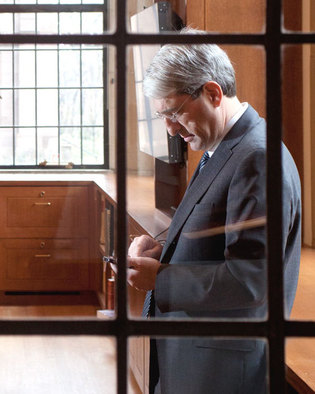 loading
loading
featuresThe president-elect elaboratesIn an interview, Peter Salovey went into detail on some big issues.  Mark OstowThe Yale Corporation Yale's board of trustees, announced on November 8 that they had unanimously elected Peter Salovey '86PhD (above, coping with his burgeoning in-box) as the next president of Yale. View full imageOn being an insider: “I have been here a long time: 31 years including graduate school. Of course I have ideas about issues I want to work on, and I will be sharing them with the community in the not-too-distant future. But I want those ideas to be heavily influenced by what I’ve learned from others. Right now I’m meeting with each of the deans of the schools. I’ve met with several student leaders, I’ve met with members of the search committee one-on-one, and I’m looking forward to putting groups of faculty, groups of staff, and larger groups of students together, going on the road, talking to alumni—you get the idea. I don’t want to articulate a detailed vision uninformed by that process. “One of the statements I often make when I speak with people in these meetings is: ‘Let’s imagine that I was hired from outside of Yale. What would you want to tell the president-elect coming to Yale from somewhere else?’ People reveal all kinds of things that are quite compelling—and that I didn’t know.”
About the four goals he named in his acceptance speech: “a more unified Yale, a more innovative Yale, a more accessible Yale, and a more excellent Yale.” “These are, obviously, broad values, and until one develops strategies and tactics around these values, it may be hard to appreciate what they really stand for. But actually, in considering new programs that are pitched to me as provost, it’s been helpful to think about these four values and ask, ‘How many are incorporated in this program?’ They become a starting point for conversation and decision-making.”
“Unified”: “But let me take a minute to talk about each one. By ‘unified,’ I mean interconnected or interdependent. When departments, programs, and schools collaborate, the whole becomes greater than the sum of the parts. There are many examples. Here’s one from the last month. The School of Engineering announced the opening of a Center for Design and Innovation that has students incredibly excited; five hundred have signed up as members! It has three-dimensional printers and various kinds of fabrication machines and many other computer-assisted design tools. It makes engineering very tangible. The next thing I know, the dean of the School of Art and the dean of the School of Engineering are on the phone with each other talking about using this facility jointly, with art students and faculty collaborating with engineering students and faculty.”
“Innovative”: “There are so many firsts at Yale: the first PhD in America, the first doctorate to an African American, the first university-based art gallery and art school, just to name a few. We should always ask ourselves, what is a unique or especially creative way we can introduce a new program, research direction, or educational approach to the world? Is there a ‘Yale way’ of doing this? I think our partnership with the City of New Haven over the past two decades with support for the retail environment, home ownership, and educational reform —brought about, in part, by Bruce Alexander’s excellent work and a close relationship between the university president and the city’s mayor—represents innovation of a kind that is quite inspiring.
“Accessible”: “We are a university that has such treasure—whether we’re talking about intellectual treasure embodied by our faculty, the collections of our museums, libraries, and galleries, or our gifted and societally engaged students. But how do we allow more of the world to access that treasure? The spectacular renovation of the Yale University Art Gallery was developed, in part, with an eye not only to expanding the teaching resources available to our faculty and students, but also to increasing access to Yale’s collections for schoolchildren from New Haven and the surrounding areas, for example. I think projects involving the digitization of our collections and in the digital humanities are other great examples. We have an obligation to the world to make sure that people know what we have here, and to make it easy to use, learn from, and be inspired by our treasures. “‘Accessible’ has a related meaning: how do we make sure that a Yale education, whether it’s undergraduate, grad, or professional, is accessible to the most deserving potential students—in part by providing financial support to students who can’t afford that education otherwise? Accessible because we make potential students aware of Yale, particularly students who might be in parts of the world or parts of this country where they don’t think Yale is possible for them.”
“Excellent”: “And finally excellence: in some ways, easier to define and harder to achieve. We should always be asking ourselves—as we think about new programs, new opportunities—is this an activity that either will be excellent, can be excellent, or would enhance the excellence of something else that we are doing? And if we can’t answer one of those questions positively, we should pause to consider whether it makes sense to pursue it. Why would we want to do anything that isn’t best in class? That should always be our aspiration.”
The comment period has expired.
|
|